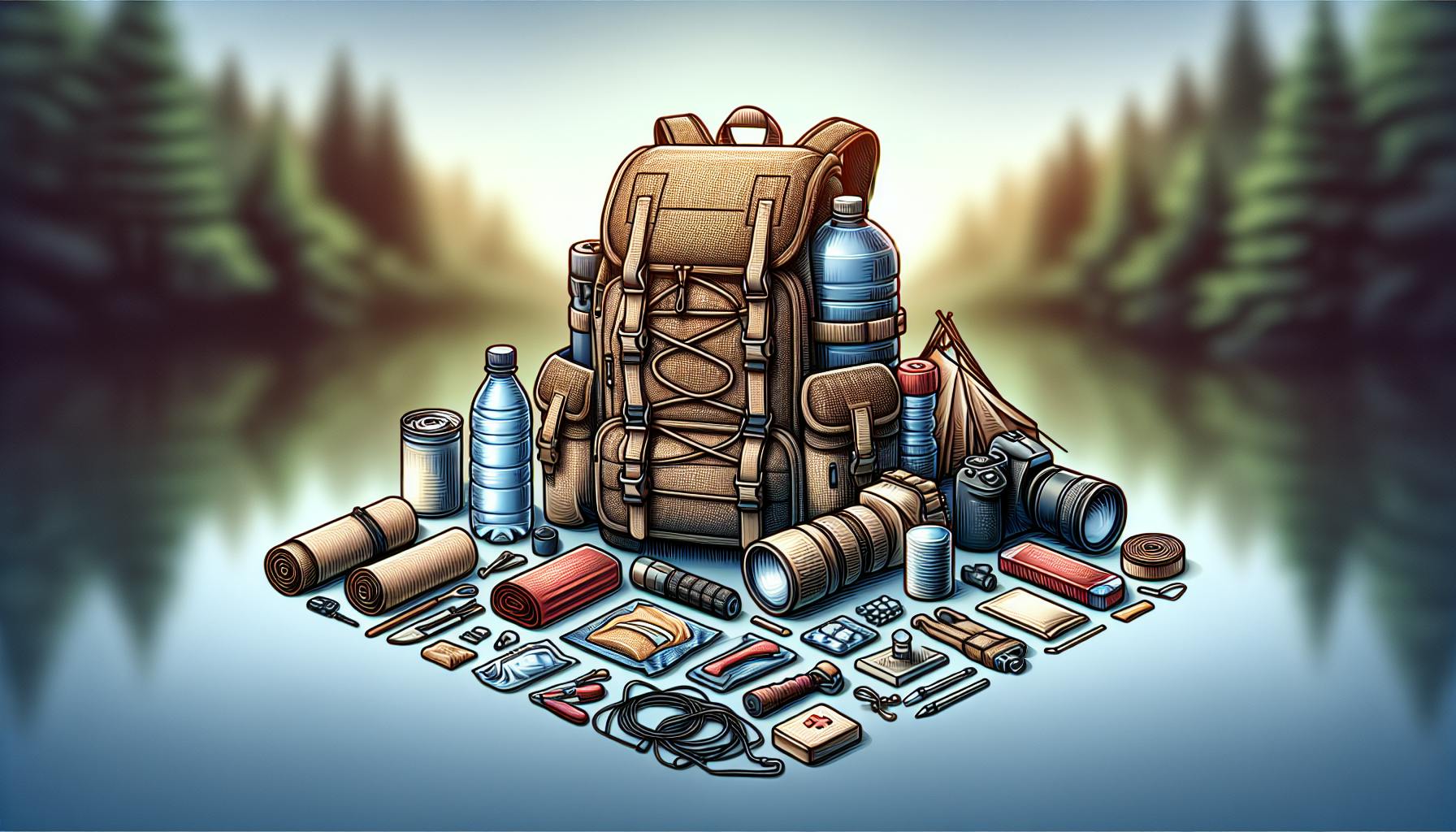Preparing for emergencies is crucial, but assembling a well-balanced bug out bag can be tricky.
This comprehensive guide outlines the essential items to include, with a focus on tailoring your bag to your unique needs and situation.
You'll learn strategies for packing the most critical survival gear while optimizing space and weight, ensuring you have the best bug out bag ready for action when you need it most.
Crafting the Best Bug Out Bag for Emergencies
A bug out bag is critical for emergency preparedness, containing vital supplies to sustain you when evacuating quickly. This guide covers key steps for creating a complete bug out bag tailored to your needs.
Understanding the Concept of a Bug Out Bag
A bug out bag, sometimes called a tactical or ultimate survival kit, is a portable package of gear and essentials you'd need to survive for several days if disaster strikes. It prepares you to evacuate at a moment's notice. Key reasons to have one:
- Allows you to leave dangerous areas fast without forgetting critical items
- Provides basic survival necessities if supply chains and infrastructure fail
- Can be customized to your climate, needs, skills, and potential risks
- Gives peace of mind knowing you have an emergency lifeline
Crafting a bug out bag is essential for responsibility preparedness.
Determining Your Bug Out Bag Essentials
Tailor your bug out bag contents based on:
- Your region's likely disasters and weather conditions
- Specific medical needs for your family
- Useful skills and survival knowledge you have
- Distance to safety locations you'd need to reach
Basic categories to include:
- Water - Vital for survival; pack durable bottles and purification tools
- Food - High-calorie, long-shelf life bars, cans for short-term needs
- Shelter - Tent, tarp, and sleeping items like bag and mat
- Clothing - Outfits for both hot and cold weather
- Tools - Knives, lighters, paracord, duct tape, multi-tool
- Medical - First aid supplies, medications, hygiene items
- Light - Flashlight, glow sticks, headlamp for hands-free
- Communication - Emergency radio, whistle, signal mirror
Add other mission-critical items as relevant. Update based on latest recommendations.
Selecting the Best Bug Out Bag: Key Features
Choose a durable, ergonomic backpack with:
- Water-resistant fabric
- Multiple compartments
- Padded shoulder straps
- Waist and chest straps for stability
- Capacity of 40-60 liters
Test bags with full weight before buying. Optimize comfort for extended wear.
The Importance of Regularly Updating Your Bug Out Bag
Re-evaluate your bag's contents twice a year as needs change:
- Check expiration dates, replace expired items
- Update quantities needed for your group
- Add gear to cover new risks in your area
- Swap in better versions of important items
- Remove unused items to reduce weight
Keeping it current ensures readiness when every second counts.
Practical Tips for Packing and Organizing Gear
Utilize compartments, bags, and containers to efficiently organize:
- Group similar items like food, medical, tools
- Put critical items like radio and lighter in easy-access spots
- Waterproof important documents and cash
- Distribute weight evenly so straps don't dig in
- Attach essentials to outside for rapid access
Test and practice accessing gear quickly. Streamline so you know where everything is located.
Following these steps will equip you with a complete, personalized bug out bag for emergency preparedness tailored exactly to your needs. Stay safe out there!
Essential Gear for Your Ultimate Survival Kit
Critical Survival Items for Shelter and Warmth
Having shelter and warmth is critical for survival in an emergency situation. Here are some must-have items to pack in your complete bug out bag:
- A durable, lightweight tent that can withstand the elements
- A warm sleeping bag with a comfort rating appropriate for your climate
- An emergency thermal blanket to retain body heat
- A tarp for creating makeshift shelters
- Paracord for securing shelters and gear
Make sure to choose gear that balances portability with insulating performance to create your ultimate survival kit.
Water Purification and Hydration Systems
Access to potable water is extremely important when bugging out. Consider packing:
- A portable water filter or purifier like the Sawyer Mini or LifeStraw
- Water purification tablets like Potable Aqua
- A metal water bottle or hydration reservoir
- A collapsible water carrier or foldable bucket
Having multiple options for treating and storing water provides redundancy in your bug out bag medical kit list.
Nutrition: Selecting and Packing Emergency Food Supplies
When packing food for your go-bag, choose calorie-dense options that don't easily spoil like:
- High-protein granola or protein bars
- Nuts, seeds, and dehydrated fruits or vegetables
- Peanut butter packets
- Canned meats like tuna, chicken or beef
- Beef jerky or pemmican
Aim for foods with a long shelf life that can sustain you during an emergency without refrigeration. This ensures your bug out bag kit has adequate nutrition.
Bug Out Bag Medical Kit List: First Aid Essentials
A first aid kit tailored for survival scenarios can mean the difference between life and death. Some essentials include:
- Various sterile bandages and gauze pads
- Antibiotic and anti-itch creams
- Disinfectants like alcohol, betadine, or hydrogen peroxide
- Medications like antihistamines, pain relievers, antacids
- Medical tools like trauma shears, tweezers, thermometers
Research and pack supplies to treat injuries, allergies, infections, and common medical issues when planning your medical bug out bag contents.
Tools for Navigation, Signaling, and Self-Defense
In addition to basics like food, water and shelter, also consider:
- Emergency whistle and signal mirror for attracting help
- Pepper spray or a tactical knife for self defense
- Map of the area, compass, GPS device, or other navigation aids
- LED flashlight, glow sticks, and other markers
- Multitool or Swiss Army Knife
Having the right tools for navigation, safety, and signaling can be vital to your survival in an emergency scenario. Choose durable, reliable options to include in your tactical bug out bag or ultimate survival kit.
sbb-itb-b932644
Clothing and Personal Protection
When building your bug out bag, choosing the right clothing and protective gear is crucial for keeping you safe and mobile in various conditions.
Layering Strategies for Various Weather Conditions
Having versatile layers that can be added or removed is key for adapting to changing temperatures. Start with moisture-wicking base layers, then use insulating mid-layers like fleece, topped by a waterproof and breathable outer shell. You'll want options for both hot and cold weather.
Durable Footwear for Rugged Terrains
Invest in waterproof hiking boots with ankle support and rugged tread to handle rough trails while carrying a heavy pack. Break them in ahead of time. Waterproof trail runners are lighter but less protective. Have spare socks.
Rain Gear and Thermal Protection
Pack both rain ponchos/jackets and insulated gear like a puffy jacket. Wool socks, glove liners, and neck gaiters also retain heat. Hand and foot warmers are useful as backup. Staying dry and regulating body temperature is vital.
Tactical Gloves and Headwear
Choose fingerless tactical gloves to allow dexterity while protecting your hands from cuts, scrapes, etc. Wide-brimmed hats shield from sun and rain. Neck gaiters or balaclavas protect from wind, dust, etc.
Sunglasses and Sunscreen for UV Protection
Pack UV-blocking sunglasses to prevent snow blindness or eye damage. Bring high-SPF sunscreen as well to prevent painful sunburns. Both help avoid dangerous medical issues.
Having versatile, protective clothing lets you travel safely through difficult terrain in any climate while keeping your mobility and health intact. Choose gear that balances durability, weight, and performance for your needs.
Communication and Power Supplies
Ensuring you have the means to communicate with the outside world and power your devices in the absence of traditional power sources is critical when building your bug out bag. Here are some key items to consider including:
Two-Way Radios and Emergency Signal Devices
Pack a set of reliable two-way radios so you can communicate with members of your group who may be separated. Handheld versions like walkie-talkies are lightweight and don't require external power. Also consider an emergency beacon or personal locator device that can send out a distress signal if needed.
Solar Chargers and Power Banks
A compact solar charger panel lets you harness power from the sun to charge devices. Pair this with a high-capacity external battery pack or power bank so you can store electricity and charge your critical electronics multiple times over. Choose rugged, waterproof models with built-in LED flashlights.
Backup Batteries and Bulbs
You'll want to make sure you have spare batteries for all your battery-powered gear, especially flashlights. Stock up on common types like AA and AAA batteries. Also pack extra flashlight bulbs and fuses in case the ones in your lights burn out.
Waterproof Cases and Protective Pouches
Keep smartphones, GPS devices, radios and other electronics safe from water, dust and impacts inside a waterproof case or pouch. Make sure to test electronics within the case or pouch to ensure full functionality.
Whistles and Mirrors for Non-Electronic Signaling
As a final layer of redundancy for when your electronic devices fail in wet conditions or run out of power, carry plastic whistles and small signal mirrors. The piercing sound of a whistle can carry much farther than using your voice to call out. Mirrors can also reflect sunlight and catch the attention of search teams.
Conclusion: Your Complete Bug Out Bag Ready for Action
A complete bug out bag contains the essential items you need to survive an emergency evacuation. Assembling the right gear takes research and planning, but the effort pays off when disaster strikes. Here are some tips to keep your bug out bag ready for action.
Reviewing Your Bug Out Bag Regularly
Inspect your bug out bag every 6 months. Check expiration dates on food, water, medicine, and batteries. Replace anything that's expired or damaged. Taking stock regularly prevents nasty surprises.
Practicing with Your Gear
Conduct regular bug out bag drills. Time yourself packing your bag or setting up your shelter. Doing hands-on run-throughs builds familiarity with your gear and readiness to use it effectively when needed.
Tailoring the Bag to Your Evolving Needs
As your skills grow, reassess your bug out bag contents. Swap bulky items for compact alternatives as you learn to improvise and do more with less. Update your medical supplies, tools, and other gear to address new risks in your region.
Sharing Knowledge and Preparing with Others
Connect with like-minded preppers to exchange ideas for enhancing bug out bags. Consider making team bags with specialized equipment to share across your group. Extra hands make lighter work.
Staying Informed and Adaptable
Follow prepper news and test innovations. Refresh your supplies to utilize new survival technologies. An adaptable mindset and flexible gear loadout helps you handle whatever comes your way.


